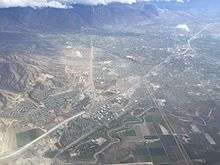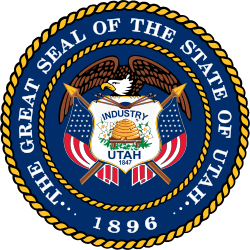American Fork, Utah
American Fork is a city in north-central Utah County, Utah, United States, at the foot of Mount Timpanogos in the Wasatch Range, north of Utah Lake. It is part of the Provo–Orem Metropolitan Statistical Area. The population was 33,161 in 2019,[6] representing a nearly 20% growth since the 2000 census.[7] The city has grown rapidly since the 1970s.
American Fork | |
|---|---|
City | |
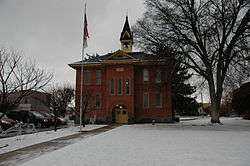 The old city hall is on the National Register of Historic Places. | |
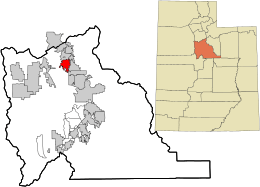 Location in Utah County and the state of Utah | |
 American Fork Location in Utah County and the state of Utah  American Fork American Fork (the United States)  American Fork American Fork (North America) | |
| Coordinates: 40°23′3″N 111°47′31″W[1] | |
| Country | |
| State | |
| County | Utah |
| Settled | 1850 |
| Incorporated | June 4, 1853 |
| Named for | American Fork (river) |
| Area | |
| • Total | 11.16 sq mi (28.90 km2) |
| • Land | 11.15 sq mi (28.87 km2) |
| • Water | 0.01 sq mi (0.02 km2) |
| Elevation | 4,606 ft (1,404 m) |
| Population (2010) | |
| • Total | 26,262 |
| • Estimate (2019)[3] | 33,161 |
| • Density | 2,974.61/sq mi (1,148.54/km2) |
| Time zone | UTC−7 (MST) |
| • Summer (DST) | UTC−6 (MDT) |
| ZIP code | 84003 |
| Area code(s) | 385, 801 |
| FIPS code | 49-01310[4] |
| GNIS feature ID | 1438194[5] |
| Website | afcity |
History
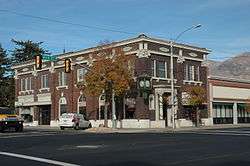
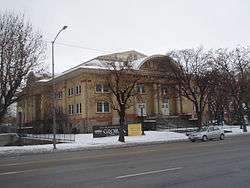
The area around Utah Lake was used as a seasonal hunting and fishing ground by the Ute Indians. American Fork was settled in 1850 by Mormon pioneers, and incorporated as Lake City in 1852. The first settlers were Arza Adams,[8] followed by Stephen Chipman (grandfather of Stephen L. Chipman, a prominent citizen around the start of the 20th Century), Ira Eldredge, John Eldredge and their families.[9]
The first settlers of American Fork lived in scattered conditions along the American Fork river. By the 1850s, tension between the settlers and Native Americans was increasing. In 1853, Daniel H. Wells, the head of the Nauvoo Legion (the Utah Territorial Militia at the time), instructed settlers to move into specific forts. At a meeting on July 23, 1853, at the schoolhouse in American Fork, Lorenzo Snow and Parley P. Pratt convinced the settlers to follow Wells' directions and all move together into a central fort. A fort was built of 37 acres (150,000 m2) to which the settlers located. Only parts of the wall were built to eight feet high, and none were built to the original plan of twelve feet high.[10]
Settlers changed the name from Lake City to American Fork in 1860. It was renamed after the American Fork which runs through the city, as well as to avoid confusion with Salt Lake City. Most residents were farmers and merchants during its early history. By the 1860s, American Fork had established a public school, making it the first community in the territory of Utah to offer public education to its citizens.[11] In the 1870s, American Fork served as a rail access point for mining activities in American Fork Canyon. American Fork had "a literal social feud" with the town of Lehi due to the Utah Sugar Company choosing Lehi as the factory building site in 1890, instead of American Fork.[12] There were several mercantile businesses in American Fork, such as the American Fork Co-operative Association and Chipman Mercantile. For several decades in the 1900s, raising chickens (and eggs) was an important industry in the city. In 1892, Joseph Forbes organized the schools in American Fork, and the Forbes school is named after him.[13]
During World War II the town population expanded when the Columbia Steel plant was built. An annual summer celebration in the city is still called "Steel Days" in honor of the economic importance of the mill, which closed in November 2001.[14] The steel mill was located approximately six miles (10 km) southeast from town, on land on the east shore of Utah Lake.
American Fork built a city hospital in 1937. A new facility was built in 1950, which was sold to Intermountain Healthcare in 1977, which in turn replaced that hospital with a new facility in 1980.[10]
The 1992 film The Sandlot was mostly filmed on the Wasatch Front. The carnival scene was filmed in American Fork on State Street by Robinson Park.[15]
Several scenes from the 1984 movie Footloose were also filmed in American Fork, including the opening scene inside the church, the front porch scene with Kevin Bacon and his family, and the gas station scene in which Bacon refuels his Volkswagen.[15]
Geography
The elevation is 4,566 feet (1,392 m) above sea level.[16]
According to the United States Census Bureau, the city has a total area of 9.2 square miles (23.9 km2), all of it land.
Demographics

| Historical population | |||
|---|---|---|---|
| Census | Pop. | %± | |
| 1870 | 1,115 | — | |
| 1880 | 1,825 | 63.7% | |
| 1890 | 1,942 | 6.4% | |
| 1900 | 2,732 | 40.7% | |
| 1910 | 3,220 | 17.9% | |
| 1920 | 3,290 | 2.2% | |
| 1930 | 3,641 | 10.7% | |
| 1940 | 3,906 | 7.3% | |
| 1950 | 5,126 | 31.2% | |
| 1960 | 6,373 | 24.3% | |
| 1970 | 7,713 | 21.0% | |
| 1980 | 13,606 | 76.4% | |
| 1990 | 15,696 | 15.4% | |
| 2000 | 21,941 | 39.8% | |
| 2010 | 26,262 | 19.7% | |
| Est. 2019 | 33,161 | [3] | 26.3% |
| U.S. Decennial Census[17] | |||
As of the census[4] of 2010, there were 26,263 people in 7,098 households residing in the city. The population density was 2,853.7 people per square mile (1,101.5/km2). The racial makeup of the city was 88.8% White (non-Hispanic), 7.4% Hispanic or Latino. 0.9% Asian, 0.5% Native American, 0.5% Pacific Islander, 0.4% African American, and 2.4% from two or more races. 3.5% of the population were foreign-born.
37.7% of the population were under 18 years old (10.6% under 5); 8.7% were 65 or older. 49.9% of the population were female. 7.1% identified themselves as being either bisexual or homosexual. 89.5% of persons over 25 had high school degrees, and 30.9% had bachelor's degrees or higher.
The median income for a household in the city was $67,124. 6.0% of the population were below the poverty line. The home ownership rate was 77.5%. There were 7,598 housing units. The median value of owner-occupied housing units was $210,600.
In 2007 there were 2,754 businesses in the city, with total retail sales over $724 million.
Religious history

The first ward of The Church of Jesus Christ of Latter-day Saints (LDS Church) in American Fork was organized in 1851 with Leonard E. Harrington as bishop. As of 2009 there are six stakes headquartered in the city as well as a temple which was dedicated in 1996.[18]
While the majority of the population are members of LDS Church, there are several other faith communities in the city. The Community Presbyterian Church of American Fork was organized in 1877. In 1973 St. Peter's Catholic Parish was organized in American Fork.[10] Additional faith groups or churches include Jehovah's Witness, Calvary Chapel and Faith Independent Baptist Church.
Education
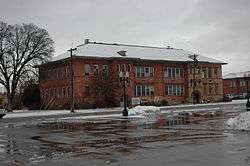
Public schools in American Fork are part of the Alpine School District and include a senior high school (American Fork High School), junior high school (American Fork Jr. High), and five elementary schools (Barratt Elementary, Forbes Elementary, Greenwood Elementary, Legacy Elementary, and Shelley Elementary).[19] Sam Jarman is the Superintendent of Schools.[20]
Private schools include American Heritage School.
Transportation

In 2012, the FrontRunner commuter rail line began operation in Utah County, opening the American Fork station.
Notable people
- Paul Dayton Bailey – author and owner of Westernlore Press
- Merrill J. Bateman – emeritus general authority of the LDS Church and former President of Brigham Young University
- Wayne Booth – literary Scholar at the University of Chicago
- Reva Beck Bosone – first female U.S. Representative from Utah
- Witney Carson – ballroom dancer on Dancing with the Stars and participant on So You Think You Can Dance
- Stephen L. Chipman, prominent LDS Church leader and businessman.
- D. Todd Christofferson - LDS Church leader and current member of the Quorum of the Twelve Apostles
- Gary Herbert – Governor of Utah
- Grant Liddle – endocrinologist
- Mia Love – U.S. Representative from Utah's 4th Congressional District
- Brandon Sanderson – fantasy author
- Daniel Wayne Sermon – lead guitarist in the rock band Imagine Dragons
- James LeVoy Sorenson – medical inventor
- Andrew Tolman – drums, percussion, backing vocals, rhythm guitar formerly of the rock band Imagine Dragons
Exchange program
American Fork has an inter-city exchange program with Indio, California, U.S. in a way similar to an international Sister City.
See also
- List of cities and towns in Utah
References
- "US Gazetteer files: 2010, 2000, and 1990". United States Census Bureau. February 12, 2011. Retrieved April 23, 2011.
- "2019 U.S. Gazetteer Files". United States Census Bureau. Retrieved August 7, 2020.
- "Population and Housing Unit Estimates". United States Census Bureau. May 24, 2020. Retrieved May 27, 2020.
- "U.S. Census website". United States Census Bureau. Retrieved January 31, 2008.
- "US Board on Geographic Names". United States Geological Survey. October 25, 2007. Retrieved January 31, 2008.
- "Population and Housing Unit Estimates". Retrieved May 21, 2020.
- "Census.gov". Archived from the original on January 22, 2015. Retrieved November 4, 2011.
- Arza Adams Archived June 14, 2010, at the Wayback Machine at SUP Pioneer Stories
- Betty G. Spencer. "American Fork" in Utah History Encyclopedia
- Spencer. Utah History Encyclopedia
- Biography of Joseph B. Forbes Archived June 8, 2008, at the Wayback Machine, Jacobson Family, Retrieved May 15, 2008
- Taylor, Fred G. (1944). A Saga of Sugar. pp. 76–77. OCLC 1041958.
- "New Forbes School Recalls Life of Educator". American Fork Citizen. June 30, 1949. p. 1.
- Geneva Steel
- Internet Movie Database
- Idcide.com
- "Census of Population and Housing". Census.gov. Retrieved June 4, 2015.
- LDS Church Almanac, 2008 Edition, p. 285-287
- "Elementary Schools". Alpine School District. Archived from the original on November 2, 2012. Retrieved November 1, 2012.
- "Administration". Alpine School District. Retrieved January 6, 2017.
External links
| Wikimedia Commons has media related to American Fork, Utah. |
| Wikivoyage has a travel guide for American Fork, Utah. |
- Official website
- Early schools in American Fork, MSS 2832 at L. Tom Perry Special Collections, Harold B. Lee Library, Brigham Young University
